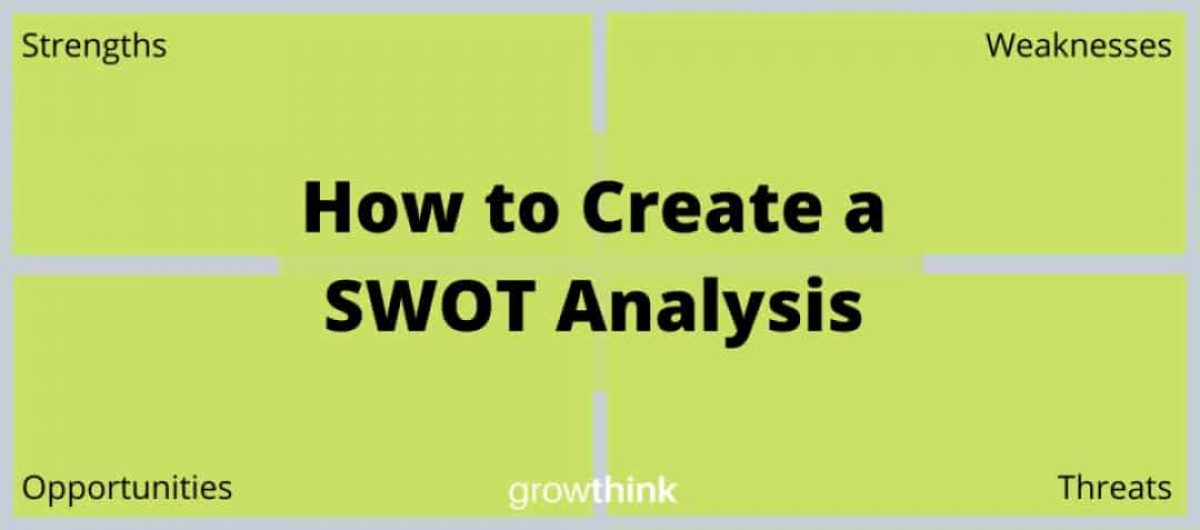A good strategist thinks holistically and flexibly. This is the purpose of a SWOT analysis. A SWOT analysis forces you to think about your business from entirely different perspectives and helps eliminate blind spots.
As an entrepreneur or a small business owner, you might think a SWOT analysis is a fancy boardroom exercise. However, this strategic tool is very easy to undertake and comes with immense paybacks. Conducting a periodic SWOT analysis ensures you and your business will not be caught off guard by internal or external changes.
A simple SWOT analysis can be applied as broadly or as narrowly as needed. You can use a SWOT analysis as a company-wide strategic planning tool or focus on a particular department or particular project within your business.
What is a SWOT Analysis?
The acronym SWOT stands for Strengths, Weaknesses, Opportunities, and Threats. A SWOT analysis is a process of reviewing your business in terms of these four factors.
Internal and External Factors in a SWOT Analysis
When you brainstorm ideas for your SWOT analysis, it’s important to consider both the internal and external factors that could impact your business.
Internal factors are the characteristics of your business that you have significant control over. Internal factors represent the unique characteristics of your entire company and they are arranged into two categories:
Internal Strengths are internal factors that increase performance or value. These include assets such as a strong brand, large customer base, favorable location, etc.
Internal Weaknesses are internal elements that reduce performance or value. These might include high operating costs, lack of patents, low market share, etc.
Strengths and weaknesses have to do exclusively with your organization and represent an internal inspection of the business. What are the things that you do right and what are the areas you could improve?
External factors are the characteristics of your business environment that you don’t have significant control over. External factors represent the uncontrollable aspects of your company and they are also arranged into four categories:
External Opportunities are external elements that present an opportunity for your business to increase its value. These might include new markets, high growth potential in important demographics, etc.
External Threats are external elements that place limits on the opportunity for your business to increase its value. These include intense competition, economic recession, government regulation, etc.
External factors that influence opportunities are external elements that can positively or negatively affect the opportunities available to your business.
External factors that influence threats are external elements that can positively or negatively impact the threats facing your business.
Opportunities and threats are external factors that influence your business. To identify them, scan and scrutinize the business landscape at large. While you cannot control opportunities and threats, a SWOT analysis helps you to capitalize on or preempt them.
Using your understanding of internal and external factors, you can shape effective long-term business strategies. By highlighting opportunities and threats that could affect the future performance of your business, the SWOT analysis provides a road map to achieving business success.
SWOT Analysis Examples
A SWOT analysis can become a solid framework for you to start a business or re-imagine your business strategy. Every business’s journey can be evolutionary in nature, and to become bigger and better, you need a firm grasp on your company, your competitors, and the business world at large.
Let’s look at several SWOT analyses for different industries.
Example #1
The SWOT analysis example below was created for a start-up organic food truck company.
| Strengths | Weaknesses |
| Good location with heavy foot traffic Local loyal customer base Locally sourced organic ingredients Popular menu Tasty food |
High operational costs Only able to serve limited customers Budgetary restraints No food delivery service yet |
| Opportunities | Threats |
| Growing trend towards locally sourced organic products Growing positive consumer attitude for local small businesses Window for growth with increasingly popular food delivery apps |
Bitter competition from other well-established food trucks and chain restaurants Rising prices of organic produce Economic fluctuations |
You can also apply the SWOT matrix format to your competitors. For that same food truck startup, take a look at the below:
| Competitor’s Strengths | Competitor’s Weaknesses |
| Better, more popular location More well-entrenched in the local community A better menu with a greater variety |
No social media presence Poor advertising and marketing skills Budgetary restraints Lack of organic ingredients |
| Competitor’s Opportunities | Competitor’s Threats |
| Moving to a better location Expanding their menu Growing trend towards organic foods Entering new markets |
Rising prices of organic produce More competition in the food truck space Economic fluctuations |
Here are a couple more SWOT analysis examples:
Example #2
The SWOT analysis diagram below was created for an existing general freight trucking company.
| Strengths | Weaknesses |
| Trusted name in the industry for over 30 years Large geographical footprint with warehouses across the country Experienced drivers who are well trained to deal with huge loads and high speeds Capital investment in latest trucking technology |
Declining market share due to entry of new competitors into the market Decline in revenue due to lower prices High customer acquisition costs for new clients Lack of funding for future growth initiatives |
| Opportunities | Threats |
| Growing interest in ‘green’ transportation practices among both manufacturers and consumers Improving consumer purchasing power Declining price of gasoline Rising cost of diesel fuel increases the relative cost-efficiency of lighter loads carried by trucks |
Rising competition from new, smaller companies Environmental regulations that may restrict freight transportation Technology advancements that allow for fewer truck drivers to move the same amount of freight |
Example #3
In the construction industry, we can see how a SWOT framework would be beneficial.
For example, a small construction company may have the following SWOT diagram:
| Strengths | Weaknesses |
| Specialize in residential renovations Low overhead costs Experienced and qualified crew Close relationship with clients |
Limited financial resources Inefficient marketing Lack of name recognition Lack of business acumen |
| Opportunities | Threats |
| Increased demand for home renovations among the growing millennial population. Growing interest in sustainable building practices among the general public |
Bitter competition from well-established renovation companies with greater resources and name recognition Regulations to keep quality control high in this industry (OSHA, EPA) Economic downturn could make financing renovations harder to secure |
Example #4
The SWOT analysis example below was created for a manufacturing company.
| Strengths | Weaknesses |
| Extensive product line with many popular items High-quality products well-suited for harsh weather Experienced workforce with a strong reputation in the local community Differentiated product offering in an increasingly competitive industry |
Highly fragmented market with numerous competitors Saturation of demand in most markets Declining profitability due to high operational costs and low prices on raw materials |
| Opportunities | Threats |
| Expansion into new geographical markets with high potential Development of new products lines that cater to specific needs of customers Partnerships with other companies to develop and sell complementary products |
Shifts in consumer preference towards low-cost alternatives Environmental regulations that increase production costs Technology advancements that allow for competitors to replicate products more cheaply |
Example #5
The SWOT analysis of a software company is as follows:
| Strengths | Weaknesses |
| Experienced and qualified workforce Large customer base with a strong foothold in the market Well-established brand name and reputation Use of latest technology and software developments |
Lack of focus on specific customer needs Inefficient marketing and distribution channels High operational costs |
| Opportunities | Threats |
| Expansion into new geographical markets with high potential Development of new products lines that cater to specific needs of customers Partnerships with other companies to develop and sell complementary products |
Shifts in consumer preference towards low-cost alternatives Environmental regulations that increase production costs Technology advancements that allow for competitors to replicate products more cheaply |
Now that you understand what a SWOT analysis is, it’s time to put it into practice.
Creating Your Own SWOT Analysis
For company-wide SWOTs, it is best to have a brainstorming exercise where every rung of management is represented. You may decide to carry out several such analyses within each department and then pool the contents into a final SWOT exercise or, if you’re a startup, a single SWOT meeting likely would suffice.
SWOT Analysis Template PDF
SWOT Analysis Template Google Docs
SWOT Analysis Template Word
Use the improved SWOT templates shared above to structure the conversations around these important issues. It is not necessary at this point to detail every point, just keep jotting down all the strengths, weaknesses, opportunities, and threats you and your team members generate.
Let’s take a deep dive into each of these elements to better understand this strategic tool.
Strengths
Strengths represent what sets your internal capabilities and resources apart from the competition. These can be both tangible and intangible. The following questions will help your team think through your organization’s strengths:
- Are your people particularly impressive, in terms of education, experience, knowledge, skills, networks, and reputation?
- Do you have highly valued company assets? For example, capital, a solid customer base, a strong location, stable distribution channels, products, credit, patents, manufacturing facilities, powerful research and development centers, intellectual property, or proprietary technology?
- Are you inundated by leads from the marketing department?
- Is your R&D team at the cusp of developing an original product?
- Do you enjoy positive media coverage?
- Do you have a strong social media presence?
- Any other internal things you do better or more effectively than your competitors?
Weaknesses
Weaknesses in the context of a SWOT analysis are your internal drawbacks that potentially put your organization at a competitive disadvantage. Below are example thought prompts that may help you identify your company’s weaknesses:
- Are you situated in a bad location that is hampering business?
- Do you have a dearth of skilled people with the right expertise?
- Do you have budgetary constraints that make it difficult to compete?
- Do you lack a unique product and/or service that is not easily marketable?
- Are there certain things your competitors ace but you do not?
- Is there some internal operation that is bleeding your business dry?
Brainstorming such weaknesses might seem like it would dampen the organizational spirit, however, to truly analyze and grow as a business you need to be constructively self-critical. You cannot begin treatment without a diagnosis.
Opportunities
Opportunities are external factors that benefit your business. As you scan the business and competitive landscape to identify unique opportunities, you may ask yourself the following questions:
- Is there a growing demand for your product and/or service because of a larger trend?
- Are there unexplored markets for your product and/or service?
- Are there lesser or weaker competitors in your area of business?
- Is there a new technology available that you can leverage to expand your business or cut existing operational costs?
- Is there an avenue for forming strategic partnerships or alliances with other businesses?
Threats
Threats are external factors that may negatively impact your business. Threats are beyond your control, but identifying and anticipating potential threats will help your business best address them. Below are some starters to help you identify external threats your business might be exposed to:
- Who are you competing against? Are new emerging competitors entering the market?
- Has there been a change in your suppliers or raw material access and availability?
- Is there a market or consumer trend that will affect your business negatively?
- Is there a tech disruptor that might eat a chunk of your business or push you out?
- Has the economy changed or deteriorated?
- Has the government changed, or might it change, regulations that affect your business?
- Is the media showing you in a bad light?
- Have people started criticizing you or pulling back from your business?
Assessing the Results of the SWOT Analysis
Now that you have completed the SWOT matrix, you need to evaluate and implement the results. A SWOT analysis is not a strategy; instead, it is a tool that will guide your strategy in the short and long term.
Start with your company’s strengths; discuss how you can further improve and entrench them. Also, analyze if those strengths could potentially turn into threats if your company becomes complacent.
Try to connect your strengths with opportunities and threats identified. Can you use your strengths to take advantage of opportunities or neutralize threats?
When it comes to weaknesses, deliberate on their root causes and involve your company’s relevant departments and people in the discussion. Again, just like you did with strengths, develop strategies you can employ to nullify your weaknesses by exploiting some opportunities or by proactively side-stepping some of the threats identified.
In this manner, you will create actionable simple business plan templates based on your SWOT analysis. These plans should be accompanied by clearly defined goals with deadlines so everyone on the team knows what is expected of them and when. Meet periodically to assess the work done, revise your goals, or even set new ones depending on your position.
By being nimble, you will be able to adapt to the worst and best of situations. Undertake a new SWOT analysis if you feel your circumstances have changed or new players have entered the market. This will ensure you are always aware of your surroundings and are never taken by surprise.
An effective SWOT analysis helps you ask the right questions and look in the right places for answers. It is a great way to examine your business and pivot if need be. Today no business can afford to be rigid and reactive, and a SWOT analysis is the starting point for developing a more prescient and relevant strategy.
How to Finish Your Business Plan in 1 Day!
Don’t you wish there was a faster, easier way to finish your business plan?
With Growthink’s Ultimate Business Plan Template you can finish your plan in just 8 hours or less!


 Download a Free Business Plan Template
Download a Free Business Plan Template How to Make a Successful Business Plan
How to Make a Successful Business Plan 100 Example Business Plans
100 Example Business Plans Expert Business Plan Consultants
Expert Business Plan Consultants The Perfect Business Plan Layout for a Great Plan
The Perfect Business Plan Layout for a Great Plan Use This Business Plan Structure to Expertly Write Your Plan
Use This Business Plan Structure to Expertly Write Your Plan